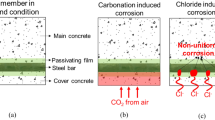Abstract
Experimental study on shear behaviour of reinforced concrete (RC) beams with corrosion damaged partial length in one shear span is presented. In order to discover how mechanical behaviour and load capacity of the RC beam were influenced by the corrosion damaged partial length, 14 RC beams including two noncorroded RC beams, four RC beams with partially unbonded length and eight RC beams with partially corroded length were designed. The different shear span-to-effective depth ratios, the different designed partial lengths located in one shear span and the different corrosion levels within the designed partial lengths were the main considered parameters. Test results are presented in detail. Due to the different bond conditions as well as different damage status in the longitudinal bars and the contacted stirrups, the structural performance, ductility, load capacity of the test specimens with partially unbonded and corroded length are quite different. Due to the severe pitting corrosion of the longitudinal bars and rupture of the contacted stirrups within partial length of one shear span, reduced load capacity, stiffness and ductility are shown in beam with higher corrosion level within longer partial length.



















Similar content being viewed by others
References
Palsson R, Mirza MS (2002) Mechanical response of corroded steel reinforcement of abandoned concrete bridge. ACI Struct J 99(2):157–162
Amleh L, Mirza MS (2004) Corrosion response of a decommissioned deteriorated bridge deck. J Perform Constr Facil 18(4):185–194
Almusallam AA, Al-Gahtani AS, Aziz AR, Dakhil FH, Rasheeduzzafar (1996) Effect of reinforcement corrosion on flexural behavior of concrete slabs. J Mater Civ Eng 8(3):123–127
Rodriguez J, Ortega LM, Casal J (1997) Load carrying capacity of concrete structures with corroded reinforcement. Construct Build Mater 11(4):239–248
Mangat PS, Elgarf MS (1999) Flexural strength of concrete beams with corroding reinforcement. ACI Struct J 96(1):149–159
Torres-Acosta AA, Navarro-Gutierreza S, Terán-Guillén J (2007) Residual flexure capacity of corroded reinforced concrete beams. Eng Struct 29(6):1145–1152
Azad AK, Ahmad S, Azher SA (2007) Residual strength of corrosion-damaged reinforced concrete beams. ACI Mater J 104(1):40–47
Chung L, Najm H, Balaguru P (2008) Flexural behavior of concrete slabs with corroded bars. Cem Concr Compos 30(3):184–193
Tapan M, Aboutaha RS (2008) Strength evaluation of deteriorated RC bridge columns. J Bridge Eng 13(3):226–236
Wang X-H, Liu XL (2010) Simplified methodology for the evaluation of the residual strength of corroded reinforced concrete beams. J Perform Constr Facil 24(2):108–119
Castel A, Francois R, Arliguie G (2000) Mechanical behaviour of corroded reinforced concrete beams—part 1: experimental study of corroded beams. Mater Struct 33(9):539–544
Vidal T, Castel A, Francois R (2007) Corrosion process and structural performance of a 17 year old reinforced concrete beam stored in chloride environment. Cem Concr Res 37(11):1551–1561
Cairns J, Zhao Z (1993) Behaviour of concrete beams with exposed reinforcement. Proc Inst Civ Eng Struct Build 99(2):141–154
Cairns J (1995) Strength in shear of concrete beams with exposed reinforcement. Proc Inst Civ Eng Struct Build 110(2):176–185
Raoof M, Lin Z (1997) Structural characteristics of RC beams with exposed main steel. Proc Inst Civ Eng Struct Build 122(1):35–51
Kim W, White RN (1999) Shear-critical cracking in slender reinforced concrete beams. ACI Struct J 96(5):757–765
Jeppsson J, Thelandersson S (2003) Behavior of reinforced concrete beams with loss of bond at longitudinal reinforcement. J Struct Eng 129(10):1376–1383
Torres-Acosta AA, Fabela-Gallegos MJ, Muñoz-Noval A, Vázquez-Vega D, Hernandez-Jimenez JR, Martínez-Madrid M (2004) Influence of corrosion on the structural stiffness of reinforced concrete beams. Corrosion 60(9):862–872
Toogoenthong K, Maekawa K (2004) Interaction of pre-induced damages along main reinforcement and diagonal shear in RC members. J Adv Concr Technol 2(3):431–443
Toogoenthong K, Maekawa K (2004) Shear capacity of damaged RC beam with partial longitudinal cracks in space. Proc Jpn Concr Inst 26(2):385–390
EI Maaddawy T, Soudki K, Topper T (2005) Long-term performance of corrosion-damaged reinforced concrete beams. ACI Struct J 102(5):649–656
Higgins C, Farrow WC III (2006) Tests of reinforced concrete beams with corrosion-damaged stirrups. ACI Struct J 103(1):133–141
Du YG, Clark LA, Chan Andrew HC (2007) Impact of reinforcement corrosion on ductile behavior of reinforced concrete beams. ACI Struct J 104(3):285–293
Wang X-H, Liang F-Y (2008) Performance of RC columns with partial length corrosion. Nucl Eng Des 238(12):3194–3202
Malumbela G, Moyo P, Alexander M (2009) Behaviour of RC beams corroded under sustained service loads. Constr Build Mater 23(11):3346–3351
China Construction Institute (2002) Code for design of concrete structures (GB 50010-2002). China Construction Institute, Beijing
EI Maaddawy T, Soudki K, Topper T (2005) Analytical model to predict nonlinear flexural behavior of corroded reinforced concrete beams. ACI Struct J 102(4):550–559
Choi K–K, Park H-G (2007) Unified shear strength model for reinforced concrete beams—part II: verification and simplified method. ACI Struct J 104(2):153–161
González JA, Andrade C, Alonso C, Feliu S (1995) Comparison of rates of general corrosion and maximum pitting penetration on concrete embedded steel reinforcement. Cem Concr Res 25(2):257–264
Yoon Y-S, Cook WD, Mitchell D (1996) Minimum shear reinforcement in normal, medium, and high-strength concrete beams. ACI Struct J 93(5):1–9
Du YG, Clark LA, Chan AHC (2005) Effect of corrosion on ductility of reinforcing bars. Mag Concr Res 57(7):407–419
Stewarta MG, Al-Harthyb A (2008) Pitting corrosion and structural reliability of corroding RC structures: experimental data and probabilistic analysis. Reliab Eng Syst Saf 93(3):373–382
Acknowledgment
This work is supported by the National Natural Science Foundation of China (No. 50508020 and No. 51178266).
Author information
Authors and Affiliations
Corresponding author
Rights and permissions
About this article
Cite this article
Wang, XH., Li, B., Gao, XH. et al. Shear behaviour of RC beams with corrosion damaged partial length. Mater Struct 45, 351–379 (2012). https://doi.org/10.1617/s11527-011-9770-5
Received:
Accepted:
Published:
Issue Date:
DOI: https://doi.org/10.1617/s11527-011-9770-5




